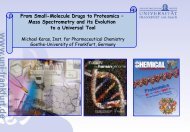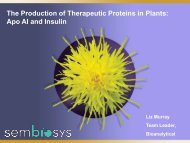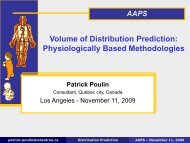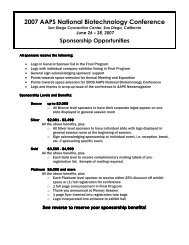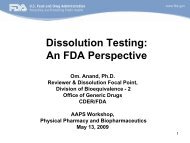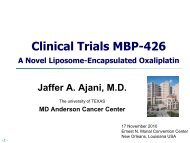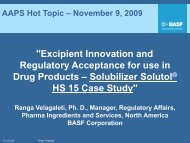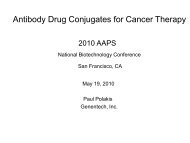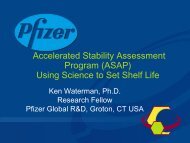Role of Pharmacogenomics in Drug Development – An Industry ...
Role of Pharmacogenomics in Drug Development – An Industry ...
Role of Pharmacogenomics in Drug Development – An Industry ...
You also want an ePaper? Increase the reach of your titles
YUMPU automatically turns print PDFs into web optimized ePapers that Google loves.
<strong>Role</strong> <strong>of</strong> <strong>Pharmacogenomics</strong> <strong>in</strong><strong>Drug</strong> <strong>Development</strong> <strong>–</strong> <strong>An</strong> <strong>Industry</strong>PerspectiveCol<strong>in</strong> SpraggsPharmacogeneticsGlaxoSmithKl<strong>in</strong>e
New Medic<strong>in</strong>es Are Increas<strong>in</strong>gly MoreExpensive To Develop1970’s1980’s1990’s$138m$318m$800m - Duration 15Yr• Need to reduce Pipel<strong>in</strong>e Attrition<strong>–</strong> >70% <strong>of</strong> cost is allocated to failures<strong>–</strong>
Variation <strong>in</strong> medic<strong>in</strong>e response to can beclassified by Pharmacogenetics• Pharmacogenetics (PGx) is the study <strong>of</strong> how drugresponse varies <strong>in</strong> <strong>in</strong>dividuals, due to differences <strong>in</strong>their DNA• Variation <strong>in</strong>cludes differences <strong>in</strong> pharmacok<strong>in</strong>etics,efficacy, safety and/or tolerability• PGx does not change how a person will respond to amedic<strong>in</strong>e• PGx is a tool that can be used to identify patients whowill have the desired response (efficacy & safety)
We want to describe <strong>in</strong>dividual risk better, now we can…2001 - Human genome known and bounded2004 - 10+ Million SNP markers mapped2005 - Human LD map (HapMap)
GSK Pharmacogenetic StrategyOngo<strong>in</strong>g <strong>in</strong>vestigations for efficacy andsafety <strong>of</strong> compounds <strong>in</strong> phase I, II, III and IVcl<strong>in</strong>ical trials• DNA (and other samples) collected from subjectsenrolled <strong>in</strong> GSK cl<strong>in</strong>ical trials• Appropriate consents - globally• ‘Collect and hold’ strategy pend<strong>in</strong>g results• >55,000 PGx samples• Samples from >70 countries• 99% ethics committee approval rate
PG Opportunities <strong>in</strong> the ‘Pipel<strong>in</strong>e’Target selectionPathway analysisResponderpopulationidentificationRisk ManagementPost Market<strong>in</strong>gSurveillanceEarly risk discharge(tolerability)TargetLeadCandidateFTIHPOCPhase 2Phase 3RegSubmissionLaunchand LCMPredictiveToxicologyExposurePK / dos<strong>in</strong>gResponders:stratify / enrich
Efficacy PGx: Opportunities• Associate genetic variation with differences <strong>in</strong>drug efficacy response• Provide the means to classify patients asresponders or non-responders• Enable enrichment <strong>of</strong> subsequent studies withresponders• Enable dose adjustments by genotype• Enable progression <strong>in</strong> responder subset forotherwise ‘failed’ drugs• More focused, better def<strong>in</strong>ed studies
PGx reveals efficacy for rosiglitazone <strong>in</strong>Alzheimer’s Disease (AD)• PPARγ agonist approved for the treatment <strong>of</strong> Type 2 Diabetes• Rationale <strong>in</strong> AD<strong>–</strong> Decl<strong>in</strong>e <strong>in</strong> cerebral glucose utilisation l<strong>in</strong>ked to AD progression<strong>–</strong> PPARγ agonists may <strong>in</strong>crease glucose bra<strong>in</strong> entry and utilization<strong>–</strong> Positive cognitive effect <strong>in</strong> pilot study (n=30)• Phase II, 24 week placebo controlled, dose rang<strong>in</strong>g study <strong>of</strong> rosiglitazoneefficacy <strong>in</strong> mild to moderate AD patients• DNA samples collected for PGx analysis <strong>of</strong> rosiglitazone response follow<strong>in</strong>gstratification <strong>of</strong> APOE4 carriage<strong>–</strong> APOE ε4 positive & APOE ε4 negative• Cl<strong>in</strong>ical study results published<strong>–</strong> Risner et al, <strong>Pharmacogenomics</strong> Journal, 2006; doi:1038/sj.tpj.6500369
APOE4 - a susceptibility gene variant forcommon forms <strong>of</strong> Alzheimer diseaseProportion <strong>of</strong> eachgenotype unaffected1.00.82/30.62/43/30.43/40.24/4060 65 70 75 80 85Age at onsetMean age <strong>of</strong>onset <strong>of</strong>Alzheimerdisease as afunction <strong>of</strong> the<strong>in</strong>heritance <strong>of</strong> thefive commonAPOE genotypes
Change from Basel<strong>in</strong>e <strong>in</strong> ADAS-CogTotal Scores <strong>in</strong> the ITT PopulationMean Change <strong>in</strong> ADAS-Cog Score-2.5-2-1.5-1-0.500.511.5Cl<strong>in</strong>icalimprovementCl<strong>in</strong>ical decl<strong>in</strong>eBasel<strong>in</strong>e Week 8 Week 16 Week 24RSG 8mg RSG 4mg RSG 2mg PlaceboTreatment differences between rosiglitazone and placebo for ADAS-Cog total scores did not reach statisticalsignificance at Week 24 LOCF. Adapted from The <strong>Pharmacogenomics</strong> Journal 2006, onl<strong>in</strong>e publication, 31January 2006; doi:10.1038/sj.tpj.6500369.
ADAS-Cog Score <strong>in</strong> APOE ε4-Negativevs. APOE ε4-Positive CohortsMean Change <strong>in</strong> ADAS-Cog Score-2.5-2-1.5-1-0.500.511.522.5Basel<strong>in</strong>e Week 8 Week 16 Week 248mg E4+8mg E4-4mg E4+4mg E4-2mg E4+ Pbo E4+2mg E4- Pbo E4-• <strong>An</strong>alysis <strong>of</strong> <strong>in</strong>teraction between APOE carriage status and ADAS Cog change frombasel<strong>in</strong>e to Week 24 was significant (P
ADAS-Cog Score <strong>in</strong> APOE ε4-Negativevs. APOE ε4-Positive CohortsMean Change <strong>in</strong> ADAS-Cog Score-2.5-2-1.5-1-0.500.511.522.5Basel<strong>in</strong>e Week 8 Week 16 Week 248mg E4+ 4mg E4+ 2mg E4+ Pbo E4+8mg E4- 4mg E4- 2mg E4- Pbo E4-• <strong>An</strong>alysis <strong>of</strong> <strong>in</strong>teraction between APOE carriage status and ADAS Cog change from basel<strong>in</strong>e to Week 24 wassignificant (P
Rosiglitazone <strong>in</strong> ADPhase III progression enabled by PGx hypothesis• Phase II Results<strong>–</strong> Results suggest AD patients without an APOE ε4 allele responded betterthan patients who carry either 1 or 2 APOE ε4 alleles<strong>–</strong> Results are exploratory and do not <strong>in</strong>form cl<strong>in</strong>ical practice, further studiesare required to confirm these f<strong>in</strong>d<strong>in</strong>gs<strong>–</strong> No conclusions can be drawn about cl<strong>in</strong>ical management <strong>of</strong> patients with AD• Prospective Phase III hypothesis<strong>–</strong> Patients without an APOE ε4 allele will show more improvement comparedto patients who carry an APOE ε4 allele<strong>–</strong> Phase III subjects will be randomised by APOE ε4 allele status(positive/negative)• Efficacy PGx<strong>–</strong> Associates genetic variation with differences <strong>in</strong> drug response<strong>–</strong> Provides the means to classify patients as responders or non-responders<strong>–</strong> Enables progression <strong>in</strong> responder subset for otherwise ‘failed’ drugs
Safety PGx: Opportunities• Associate genetic variation with drug <strong>in</strong>ducedadverse events• Provide the means to classify patients’ risk <strong>of</strong>drug <strong>in</strong>duced adverse events• Enable exclusion <strong>of</strong> ‘at risk’ patients fromsubsequent studies• Enable dose adjustment to reduce exposuredrivenAEs <strong>in</strong> ‘poor metaboliser’ patients• Potential markers require full evaluation <strong>of</strong>performance characteristics <strong>in</strong> broad studypopulation to ensure suitability for safetymanagement
Abacavir and Hypersensitivity (HSR)• Abacavir is a nucleoside reverse transcriptase <strong>in</strong>hibitor fortreatment <strong>of</strong> HIV <strong>in</strong>fection• Active agent <strong>in</strong> Ziagen, Trizivir, and Epzicom/Kivexa• Approximately 5% <strong>of</strong> patients receiv<strong>in</strong>g abacavir develophypersensitivity reaction (HSR)<strong>–</strong> Vast majority <strong>of</strong> HSR cases are non-serious adverse events andresolve with permanent drug discont<strong>in</strong>uation<strong>–</strong> HSR toxicity burden <strong>in</strong>cludes excess cl<strong>in</strong>ic visits, provision <strong>of</strong>alternate antiretroviral drug(s), hospitalizations and rare fataloutcomes• Cl<strong>in</strong>ical risk management is highly effective <strong>in</strong> reduc<strong>in</strong>gserious outcomes
Abacavir HSR and HLA B*5701Performance characteristics among ethnic groupsStudyGroupCasennp valueSensitivitySpecificityPPVNPVOR(95%CI)CNA30027Whites56744x10 -1457%99%69%98%97(12-751)CNA30032Whites1821678x10 -2348%96%37%97%21(10-48)CNA30032Hispanics51532x10 -422%100%100%95%30(2-531)CNA30032Blacks37410.278%98%12%96%4(0-36)Mallalet al18167
Abacavir HSR Prospective PGx study• A prospective study evaluate the utility <strong>of</strong>HLA-B*5701 screen<strong>in</strong>g on Abacavir HSR rate• 6 weeks treatment with Abacavir conta<strong>in</strong><strong>in</strong>gantiviral regimens (2 x 900 patients)• Comparison <strong>of</strong> HSR rates between patients<strong>–</strong> Receiv<strong>in</strong>g current standard <strong>of</strong> care (all comers)versus<strong>–</strong> Prospective HLA-B*5701 screen<strong>in</strong>g and <strong>in</strong>clusion <strong>of</strong>marker negative patients (marker positive patientsexcluded)
No Samples, No Science• Cl<strong>in</strong>ical trial pharmacogenetics requires the prospectivecollection <strong>of</strong> samples and data• Samples should be collected even <strong>in</strong> situations where studyphenotype(s) are not yet identified• Requires appropriate <strong>in</strong>formed consent• Reduces potential misrepresentation <strong>of</strong> the cl<strong>in</strong>ical trialpopulation and sample bias that may occur when samplesare collected retrospectively• DNA collection and storage enables pharmacogenetic studywhen new biological <strong>in</strong>formation emerges, even after studyhas completed• As illustrated ………
PPARγ agonist FarglitazarOedema AE PGx• PPARγ agonists are cl<strong>in</strong>ically effective treatments <strong>of</strong>Type 2 Diabetes• Most common side effects are fluid retention/oedema,can range from <strong>in</strong>convenient to cl<strong>in</strong>ical concernrequir<strong>in</strong>g discont<strong>in</strong>uation• Mechanism and optimal management not fullyunderstood
Farglitazar Cl<strong>in</strong>ical Studies• Farglitazar, PPARγ agonist <strong>in</strong> Phase III studies <strong>in</strong> Type2 diabetic patients• 647/1106 (59%) subjects provided <strong>in</strong>formed consentand DNA samples for PGx analysis whilst participat<strong>in</strong>g<strong>in</strong> cl<strong>in</strong>ical studies• 555/647 (86%) were categorised as White• White subjects were allocated to three groups basedon study treatment<strong>–</strong> Farglitazar monotherapy: 6 studies (n=337)<strong>–</strong> Farglitazar plus glyburide: 1 study (n=77)<strong>–</strong> Farglitazar plus <strong>in</strong>sul<strong>in</strong>: 2 studies (n=141)
Farglitazar oedema AE PGxSCNN1B Genetic LocusP valueGeneLDPattern(r 2 )
Farglitazar oedema AE PGx• Based on data emerg<strong>in</strong>g after completion <strong>of</strong> cl<strong>in</strong>icaltrials this study was conducted on stored DNAsamples• Several polymorphisms <strong>in</strong> SCNN1B were highlysignificantly associated with oedema adverse events <strong>in</strong>Farglitazar cl<strong>in</strong>ical trials• These f<strong>in</strong>d<strong>in</strong>gs strengthen the hypothesis implicat<strong>in</strong>grenal sodium handl<strong>in</strong>g <strong>in</strong> the development <strong>of</strong> PPARγ<strong>in</strong>duced fluid retention and suggest opportunities formanagement (eg, amiloride)• “No samples, no science”
Ethical considerations• PGx is not ‘exceptional’• PGx <strong>in</strong>formation is treated the same as othercl<strong>in</strong>ical data<strong>–</strong> DNA samples are collected follow<strong>in</strong>g cl<strong>in</strong>icaltrial <strong>in</strong>formed consent<strong>–</strong> DNA samples for PGx are coded to protectpatient identity• Primary goal <strong>of</strong> PGx is to <strong>in</strong>vestigate geneticvariation relat<strong>in</strong>g to drug effects, not to predictlikelihood <strong>of</strong> develop<strong>in</strong>g a disease
PGx is happen<strong>in</strong>g now• Rout<strong>in</strong>e DNA collection <strong>in</strong> cl<strong>in</strong>ical trials• Retrospective analysis <strong>of</strong> efficacy and safety<strong>–</strong> Hypothesis generation• Prospective Efficacy PGx and Safety PGx<strong>–</strong> Hypothesis test<strong>in</strong>g<strong>–</strong> Cl<strong>in</strong>ical study design• Applications will be case specific<strong>–</strong> Support <strong>in</strong>ternal decision mak<strong>in</strong>g<strong>–</strong> Support Regulatory approval<strong>–</strong> May not result <strong>in</strong> a PGx test• High <strong>in</strong>terest and engagement from Regulators andHealthcare policymakers



